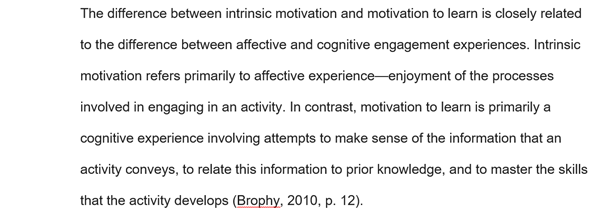General rules for in-text citations
When you are paraphrasing or using a direct quote in your writing you must acknowledge each author or source of information (whether print or online).
Paraphrasing
Paraphrasing is when you are expressing the ideas of the author in your own words. When you are paraphrasing you must acknowledge each author or source of information with a citation.
Use round brackets to add the author’s family name and the year of publication, or use the author’s family name as part of your sentence, followed by the year of publication in round brackets.
When paraphrasing, the citation details can be used at the beginning, middle or end of the sentence.
Citation at the beginning
Brophy (2010) states that student motivation . . .
Citation in the middle
. . . motivation is evident (Brophy, 2010), and as a result, can contribute significantly to achieving learning goals.
Citation at the end
. . . where a number of subjective experiences can inform motivational outcomes (Brophy, 2010).
Citations can also be structured according to whether they give prominence to the author, or to the information being conveyed.
Author-prominent or narrative citations
This type of citation incorporates the name of the author as part of the sentence followed by the date in brackets.
In his research, Brophy (2010) argues that . . .
With author-prominent citations, after the first citation in a paragraph you do not need to include the year in subsequent author-prominent citations in the same paragraph as long as the study cannot be confused with others.
Felton and Royal (2015) argue that…. The population studied by Felton and Royal was…..
Information-prominent or parenthetical citations
This type of citation has the author's name and date inside brackets.
. . . findings are based on the qualitative study of behavioural learning (Brophy, 2010).
All information-prominent citations should include the year, regardless of how often they appear in a paragraph.
. . . identifies skills intrinsic to current nursing practitioners (Felton & Royal, 2015).
Including page numbers in a paraphrase citation
When paraphrasing, page numbers may also be included as part of the citation, especially if it helps the reader locate the source of the information in a lengthy document. Including page numbers when paraphrasing is optional and is not a requirement of the APA referencing style.
In order to establish a learning community in the classroom, it is important to motivate students by addressing both individual and collaborative learning goals (Brophy, 2010, pp. 23-24).
Direct quotes
General rules for in-text citations
When you are using a direct quote in your writing, you must acknowledge each author or source of information.
Direct quotes are used if you are using the exact words of the author. Put direct quotes between double quotation marks “ ” and add a page number. Do not overuse direct quotes.
“Student motivation to learn can be viewed as either a general disposition or a situation-specific state” (Brophy, 2010, p. 12).
If the work you are referencing does not contain page numbers, then use chapter numbers, section headings, and paragraph numbers as part of the citation.
"As the national peak body for early childhood, ECA is a regular, and trusted, contributor to the public policy debate on all matters affecting young children (birth to eight years) and their families" (Early Childhood Australia, 2016, Advocacy section, para. 1).
If you omit words from a direct quote, you need to add a space followed by three ellipsis dots ( . . . ) and another space.
Cannon (2012) argues that "changes in corporate approaches to such sensitive areas . . . will require coherent change strategies" (p. 165).
Quotations more than 40 words in length need to be in block form: without using quotation marks, begin the quote on a new line, and indent and double-space the entire quote. At the end of the quote, include citation details in brackets.
